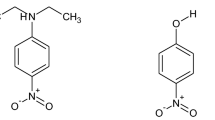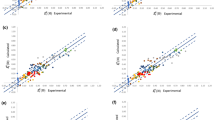Abstract
The solvent polarity/polarizability (SPP) scale is shown to be highly useful for analyzing the solvatochromic behavior of molecular systems emitting dual fluorescence by virtue of the solvent polarity. Stokes' shift data are presented on a test set of seven solutes in 58 solvents correlating with the SPP (single parameter polarity/polarizability index). SPP values for seven further solvents are given, extending the previously available list.
Similar content being viewed by others
References
Z. R. Grabowski, K. Rotkiewicz, A. Siemiarczuk, D. J. Coley, and W. Baumann (1979)New J. Chem. 3, 443.
W. Rettig (1986)Angew. Chem. Int. Ed. Engl. 25, 971.
E. Lippert, W. Rettig, V. Bonacic-Koutecky, F. Heisel, and J. A. Miehé (1987)Adv. Chem. Phys. 68, 1.
W. Rettig and W. Baumann (1992) in J. F. Rabek (Ed.),Progress in Photochemistry and Photophysics, CRC Press, Boca Raton, Chap. 3.
E. Lippert, W. Luder, and H. Boss (1962)Adv. Mol. Spectrosc. 1, 442.
F. Scheneider and E. Lippert (1968)Ber. Bunsenges. Phys. Chem. 72, 1155.
F. Scheneider and E. Lippert (1970)Ber. Bunsenges. Phys. Chem. 74, 624.
J. Catalán, V. López, P. Pérez, R. Martin-Villamil, and R. Rodríguez (1995)Liebigs Ann. 241.
J. Catalán, V. López, and P. Pérez,Chem. Ber. (in press).
E. Lippert (1955)Z. Naturforsch. 10a, 541; (1957)Z. Elektrochem. 61, 962; (1956)Z. Phys. Chem. N.F. 6, 125.
N. Mataga, Y. Kaifu, and M. Koizumi (1955)Bull. Chem. Soc. Jap. 28, 690; (1956)29, 465.
N. Mataga and Y. Torihashi (1963)Bull. Chem. Soc. Jap. 36, 356.
N. Mataga (1963)Bull. Chem. Soc. Jap. 36, 620; (1963)36, 654.
Y. Ooshika (1954)J. Phys. Japan. 9, 594.
N. G. Bakhshiev (1961)Opt. Spektrosk. 10, 717; (1962)12, 473; (1962)Ukr. Fix. Zh. 7, 920; (1963)Dokl. Akad. Nauk. SSSR 152, 577; (1964)Opt. Spektrosk. 16, 821; (1965)19, 345; (1965)19, 535.
L. Onsager (1936)J. Am. Chem. Soc. 58, 1486.
L. R. Khundkar and A. H. Zewail (1986)J. Chem. Phys. 84, 1302.
K. Yamasaki, K. Arita, O. Kajimoto, and K. Hara (1986)Chem. Phys. Lett. 123, 277.
O. Kajimoto, K. Yamasaki, K. Arita, and K. Hara (1986)Chem. Phys. Lett. 125, 184.
A. Subaric-Leitis, Ch. Monte, A. Roggan, P. Zimmermann, and J. Heinze (1990)J. Chem. Phys. 93, 4543.
K. Honma, K. Arita, K. Yamasaki, and O. Kajimoto (1991)J. Chem. Phys. 94, 3496.
W. A. Acree, Jr., D. C. Wilkins, S. A. Tucker, J. M. Griffin, and J. R. Powell (1994)J. Phys. Chem. 98, 2537.
L. U. Bilot and A. Kawski (1962)Z. Naturforsch. 17a, 621.
G. A. Reynolds and K. H. Drexhage (1975)Opt. Commun. 13, 222.
R. F. Kubin and A. N. Fletcher (1983)Chem. Phys. Lett. 99, 49.
G. Jones II, W. R. Jackson, S. Kanoktanaporn, and A. M. Halpern (1980)Opt. Commun. 33, 315.
G. Jones II, W. R. Jackson, C. Choi, and W. R. Bergmark (1985)J. Phys. Chem. 89, 294.
M. Maroncelli and G. R. Fleming (1987)J. Chem. Phys. 86, 6221.
A. Gaplosvky, P. Hrdlovic, J. Donovalová, and P. Hrnciar (1991)J. Photochem. Photobiol. A Chem. 59, 221.
K. Dimroth, C. Reichardt, T. Siepmann, and F. Bohlmann (1963)Ann. Chem. 661, 1; K. Dimroth and C. Reichardt (1969)Ann. Chem. 727, 93; C. Reichardt (1971)Liebigs Ann. Chem. 752, 64; C. Reichardt (1979)Angew. Chem. 91, 119; C. Reichardt (1992)Chem. Soc. Rev. 21, 147.
M. S. A. Abdel-Mottaleb, M. S. Antonious, M. Abo-Aly, L. F. M. Ismaiel, B. A. El-Sayed, and A. M. K. Sherief (1989)J. Photochem. Photobiol. A Chem. 50, 259.
M. Zander and W. Rettig (1984)Chem. Phys. Lett. 110, 602.
J. Dobkowski, Z. R. Grabowski, B. Paeplow, W. Rettig, K. H. Koch, K. Müllen, and R. Lapouyade (1994)New J. Chem. 18, 525.
Author information
Authors and Affiliations
Corresponding author
Rights and permissions
About this article
Cite this article
Catalán, J., López, V. & Pérez, P. Use of the SPP scale for the analysis of molecular systems with dual emissions resulting from the solvent polarity. J Fluoresc 6, 15–22 (1996). https://doi.org/10.1007/BF00726722
Received:
Accepted:
Issue Date:
DOI: https://doi.org/10.1007/BF00726722




